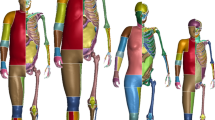Abstract
Vehicle safety has become the most important issue in automobile design. However, all efforts to improve safety devices focus on enhancing safety features for occupants. Notably, pedestrians are the second largest category of motor vehicle deaths, after occupants, and account for about 13 percent of motor vehicle deaths. It is essential to design pedestrian-friendly vehicles and pedestrian protection systems to reduce pedestrian fatalities and injuries. To effectively assess pedestrian injuries resulting from vehicle impact, a deformable pedestrian model must be developed for vehicle-pedestrian collision analysis. This study constructs a pedestrian-collision numerical model based on LS-DYNA finite element code. To verify the accuracy of the proposed deformable pedestrian model, experimental data are used in the pedestrian model test. This study applies the proposed model to analyze the dynamic responses and injuries of pedestrians involved in collisions. The modeled results can help assess vehicle pedestrian friendliness and assist in the future development of pedestrian-friendly vehicle technologies.
Similar content being viewed by others
Refereces
Astrid, L., Anthony, C., Clay, D., Brian, F., Jikuang, Y. and Laurie, S. (2004). Mathematical modelling of pedestrian crashes: Review of pedestrian models and parameter study of the influence of the sedan vehicle contour. Proc. 2004 Road Safety Research, Policing and Education Conf., 10.
Ishikawa, T., Kore, H. and Furumoto, A. (2003). Susumu kuroda-evaluation of pedestrian protection structures using impactors and full-scale dummy tests. ESV 18th Conf., Paper No. 271.
Jason, S. and Barsan-Anelli, A. (2001). Adaptation of a human body mathematical model to simulation of pedestrian/vehicle interaction. 4th MADYMO User’s Meeting of the America’s, Detroit, October 24th.
Lex, V. R., Kavi, B., Mark, M., Johan, I., Jeff, C., Douglas, L., Yukou, T., Yasuhiro, D. and Yuji, K. (2003). Pedestrian crash reconstruction using multi-body modeling with geometrically detailed, validated vehicle models and advanced pedestrian injury criteria. ESV 18th Conf., Paper No. 468.
Matsui, Y., Wittek, A. and Konosu, A. (2002). Comparison of pedestrian subsystem safety tests using impactors and full-scale dummy tests. SAE 2002 World Cong., SAE Paper No. 2002-01-1021.
Masami, I., Kiyioshi, O., Hideyuki, K., Yuko, N., Atsutaka, T., Isao, W., Kazuo, M., Junji, H. and Fuminori, O. (2002). Recent advanes in THUMS: Development of individual internal organs, brain, small female, and pedestrian model. 4th European LS-DYNA Users Conf.
Mizuno, K., Yonezawa, H. and Kajzer, J. (2001). Pedestrian headform impact tests for various vehicle locations. ESV 17th Conf., Paper No. 278.
NHTSA (2006). NHTSA’s (National Highway Traffic Safety Administration) Annual Assessment of Motor Vehicle Crash: Motor Vehicle Traffic Crash Fatality Counts and Estimates People of Injured for 2005.
Teng, T.-L. and Le, T.-K. (2009). Development and validation of pedestrian deformable finite element model. J. Mechanical Science & Technology 123,8, 2268–2276.
Wu, C. C. (2003). The Analysis of Occupant Injury in Frontal Impact of Traffic Accident. M. S. Thesis. Da-Yeh University. Taiwan.
Yang, J. (2002). Review of Injury Biomechanics in Car-Pedestrian Collisions. Report to European Passive Safety Network. February 28.
Yoshiuki, M. and Hirotoshi, I. (2001). Summary of IHRA pedestrian safety WG activities — Proposed test methods to evaluate pedestrian protection afforded by passenger cars. ESV 17th Conf., Paper No. 280.
Author information
Authors and Affiliations
Corresponding author
Rights and permissions
About this article
Cite this article
Teng, T.L., Le, T.K. & Ngo, V.L. Injury analysis of pedestrians in collisions using the pedestrian deformable model. Int.J Automot. Technol. 11, 187–195 (2010). https://doi.org/10.1007/s12239-010-0024-2
Received:
Revised:
Published:
Issue Date:
DOI: https://doi.org/10.1007/s12239-010-0024-2




